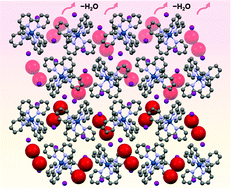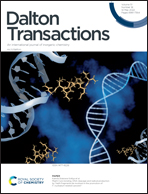Vapochromism of an iridium(iii) bis-terpyridine complex based on the modulation of halide-to-ligand charge transfer transition†
Abstract
We report, for the first time, a color change originating from the shift of the halide-to-ligand charge transfer (XLCT) band of the Ir(III) bis-terpyridine complex crystal in response to the sorption/desorption of water of crystallization. Red and orange coloration reversibly takes place by heat and cool treatments, respectively. Single X-ray crystallography shows that the Ir(III) complex possesses two waters of crystallization constructing a dimer structure, rO–O = 2.911 Å, by hydrogen bonding. It was found that the water dimer connects to one of the iodide ions with rO–I = 3.664 Å by hydrogen bonding and comes into contact with another iodide ion with rO–I = 3.747 Å, suggesting that water desorption from the crystal easily changes the XLCT transition arising from the interaction between the iodide ion 5p orbital and tpy π* orbital. Thermogravimetry measurement reveals the stepwise water desorption from the crystal, and powder X-ray diffraction shows the robustness of the Ir(III) complex crystal framework during the sorption/desorption cycles. Nitrogen gas flow or presence of a polar organic solvent contributes to the red-shift of the XLCT absorption band due to the desorption of water molecules resulted by the shift of equilibrium between water molecules in the crystal and vaporized water molecules. Exposure to ammonia vapor from 25% aqueous ammonia is found not to contribute to the color change of the Ir(III) complex crystal.



 Please wait while we load your content...
Please wait while we load your content...